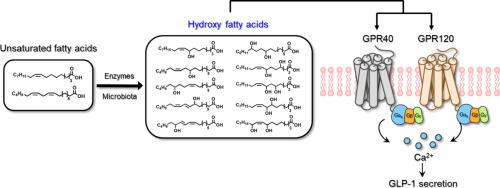Unveiling the biological activities of the microbial long chain hydroxy fatty acids as dual agonists of GPR40 and GPR120
IF 5.4
2区 医学
Q2 MATERIALS SCIENCE, BIOMATERIALS
引用次数: 0
Abstract
The physiological functions of various fatty acid-originating metabolites from foods and fermented products remained mostly untouched. Thereby, this study examined the biological activities of hydroxy fatty acids as agonists of G protein-coupled receptors (i.e., GPR40 and GPR120), which are derived from long-chain fatty acids (e.g., oleic acid and linoleic acid) by microbiota. Cell-based Ca2+ mobilization assays and in silico docking simulations revealed that not only the degree of unsaturation but also the number and position of hydroxyl groups played a key role in their agonist activities. For instance, 8,11-dihydroxyoctadec-9Z-enoic acid exhibited significantly greater Ca2+ response in the GPR40/GPR120-expressing cells as compared to the endogenous agonists (e.g., linoleic acid and docosahexaenoic acid), forming hydrogen bond interactions with residues in the ligand-binding pockets of receptors. This study will contribute to understanding the relationships between fatty acid structures and agonist activities.

揭示微生物长链羟基脂肪酸作为 GPR40 和 GPR120 双激动剂的生物活性
食品和发酵产品中各种脂肪酸代谢产物的生理功能大多仍未得到研究。因此,本研究考察了羟基脂肪酸作为 G 蛋白偶联受体(即 GPR40 和 GPR120)激动剂的生物活性。基于细胞的 Ca2+ 调动试验和硅学对接模拟显示,不仅是不饱和程度,羟基的数量和位置也对它们的激动剂活性起着关键作用。例如,与内源性激动剂(如亚油酸和二十二碳六烯酸)相比,8,11-二羟基十八碳-9Z-烯酸在 GPR40/GPR120 表达细胞中表现出明显更强的 Ca2+ 反应,与受体配体结合袋中的残基形成氢键相互作用。这项研究将有助于了解脂肪酸结构与激动剂活性之间的关系。
本文章由计算机程序翻译,如有差异,请以英文原文为准。
求助全文
约1分钟内获得全文
求助全文
来源期刊

ACS Biomaterials Science & Engineering
Materials Science-Biomaterials
CiteScore
10.30
自引率
3.40%
发文量
413
期刊介绍:
ACS Biomaterials Science & Engineering is the leading journal in the field of biomaterials, serving as an international forum for publishing cutting-edge research and innovative ideas on a broad range of topics:
Applications and Health – implantable tissues and devices, prosthesis, health risks, toxicology
Bio-interactions and Bio-compatibility – material-biology interactions, chemical/morphological/structural communication, mechanobiology, signaling and biological responses, immuno-engineering, calcification, coatings, corrosion and degradation of biomaterials and devices, biophysical regulation of cell functions
Characterization, Synthesis, and Modification – new biomaterials, bioinspired and biomimetic approaches to biomaterials, exploiting structural hierarchy and architectural control, combinatorial strategies for biomaterials discovery, genetic biomaterials design, synthetic biology, new composite systems, bionics, polymer synthesis
Controlled Release and Delivery Systems – biomaterial-based drug and gene delivery, bio-responsive delivery of regulatory molecules, pharmaceutical engineering
Healthcare Advances – clinical translation, regulatory issues, patient safety, emerging trends
Imaging and Diagnostics – imaging agents and probes, theranostics, biosensors, monitoring
Manufacturing and Technology – 3D printing, inks, organ-on-a-chip, bioreactor/perfusion systems, microdevices, BioMEMS, optics and electronics interfaces with biomaterials, systems integration
Modeling and Informatics Tools – scaling methods to guide biomaterial design, predictive algorithms for structure-function, biomechanics, integrating bioinformatics with biomaterials discovery, metabolomics in the context of biomaterials
Tissue Engineering and Regenerative Medicine – basic and applied studies, cell therapies, scaffolds, vascularization, bioartificial organs, transplantation and functionality, cellular agriculture
 求助内容:
求助内容: 应助结果提醒方式:
应助结果提醒方式:


